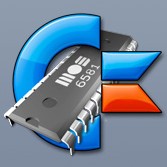I’m not a true mechanical keyboard enthusiast. I mean I like a good keyboard for typing code, so I rolled with model-Ms in the 80s and 90s, then some expensive Cherry keyboard I only recently retired because it was utterly spent (and it was PS/2), and now I happily use a Wooting Two HE.
I’m so glad the mechanical gaming keyboard scene has developed so much: it means there’s a plethora of really excellent keyboards for the rest of us who don’t play games.
But something utterly baffles me: why are high-quality keyboards getting smaller?
There’s a lot more keyboards without the numpad and the block of middle keys - whatever they’re called - or with the middle keys reduced or squashed up awkwardly on the side, than full-size plain old 102- or 104-key layout keyboards. What’s wrong with the numpad? Isn’t more keys generally better?
Back in the days, I bought the original Happy Hacking keyboard because it kind of made sense to maneuver around in our server room with a small keyboard that took up less space. Typing on it drove me up the wall but it was convenient to carry. And I guess it was also good option for going to LAN parties with a smaller backpack. But other than that, for a keyboard that never leaves your desk, I don’t get it.
Are there other advantages to smaller keyboards? Genuine question! I’m not dumping on smaller keyboards: to each his own and if you’re happy with yours, more power to you. I’d just like to know why you prefer smaller.
I have a 40% ortholinear kb because it’s more ergonomic. My fingers are never have to travel more than 2 keys away from home row. There are enough built in layers that I never feel like I’m missing a key. All keys are remappable. Beyond that I think it looks neat - folks always ask about it when they see it. When using a mouse and keyboard, my arms are kept at a reasonable distance apart (overall hands are closer together), so I can work or game longer without feeling like my shoulders or back are strained.
I like the ability to remove or add the numb pad depending on the work or play.
Okay that makes sense: it means you have a full-size keyboard for work, a mini keyboard for gaming and you use whichever works best for you for the task at hand.
But that implies there are a lot more gamers with a preference for smaller keyboards than general-purpose typists with a preference for the full-size traditional layout, because the majority of the quality mechanical keyboards offering is smaller keyboards. I have a hard time believing the gaming market is larger than the general computing market.
Or maybe gamers pay more attention to the quality of their keyboards and spend more money on them, making them a more attractive demographic.
You can just get a usb number pad for a few bucks.
I find it kind of ironic to spend 300 eur on a custom mechanical keyboard just to pair it with a usb number pad worth “few bucks” though
Some part of that is that a lot of the mech keyboards are DIY projects, and smaller keyboards are cheaper and simpler to put together.
I personally am a split ergonomic keyboard enjoyer. I use a Keebio Iris at work and a Unikeyboard Diverge TM2 at home, which are a 50% and 40% respectively, both split.
The thing that I like the most about small form factor keebs is that compared to a full keeb, I don’t have to move my hands so much to do basic and oft-repeated tasks. I don’t think about it as removing keys as much as bringing them closer to my fingers. For example, on a 40% keeb, all keys are within 1u away from your fingers’ home position.
I am totally in love with programmable layers. I programmed both of my keebs similarly. Examples:
- The key to the left from the
Akey, usually the Caps Lock key, is a dual-role key on my keebs. When you press it, it acts asEsc, and when you hold it, it acts asCtrl. - I have a key on the left half that makes my right half into a number pad. Just like that, I completely eliminate the need for a physical one, and I don’t even have to move my hand to use it.
- Switching tabs (
Ctrl+Tab,Ctrl+Shift+Tab) is a very often used pair of shortcuts for me, and they’re relatively uncomfortable to press on a full keyboard. I moved them to a much more comfortable position - I hold a key with my thumb and switch tabs with two of my other fingers without having to move any fingers from their home position. - I use virtual desktops in Windows quite a lot for working in different contexts and I mapped switching desktops (
Ctrl+Win+ arrow keys) to a similarly accessible/comfortable position, same with some others likeAlt+F4. - I am a software developer and function keys (
F1-F12) are quite frequently used in IDEs, especially in combination with modifiers (Ctrl,Shift,Alt). With a full keeb you often need to move both of your hands quite far from the home positions to press those combinations. With a small keeb, I use one of my hands to press the modifiers (which I mapped to the home row in most of my layers) and a finger from the other hand moves just 1u up from the home row.
Of course it takes a bit of trial and error, changing the way you think about how the keyboard works, and retraining your muscle memory, but as a person who spends 8+ days working with computers, I think it’s ultimately worth the investment of time, money and effort to make my weapon of choice as ergonomic and comfortable to use as possible.
For when I can’t sit at my desk and use an ergonomic keeb, I also made myself an AutoHotkey script that makes the CapsLock of a regular keyboard more useful. It would be for another writeup, but as an example, it makes it act as
Escwhen you press it and when you hold it, it activates an extra layer – as an example, it turns the keys HJKL into arrow keys (left, down, up, right) and the keys YUIO intoHome,PgDn,PgUpandEnd, and turns the numeric keys into function keys. I can still work with a full-sized keyboard, but whenever I am forced to, I am reminded how clunky it is and I long for my keeb or at least my AHK script.In summary, small keebs are cheaper and easier to make, and they bring all the keys closer to your fingertips, making it more efficient and comfortable than full keebs, with the small cost of retraining your muscle memory.
- The key to the left from the
I liked having less space between my hands (left hand on the keyboard, right hand on the mouse). I also rarely use the numpad and other keys, so the negligible sacrifice was worth it for better ergonomics.
I rock a full size realforce r2 at work AND and home because I feel more productive with a keypad and other helper keys. It’s less mental overhead. I’m not using the mouse much when I type (modal editor)
As a small keyboard user myself, I made the switch because I wasn’t using those keys anyways and the few that I were could easily be handled with layers. I have one of those desks with the sliding tray where the keyboard sits, so being able to free up space so the keyboard fits comfortably is nice.
Smaller keyboards:
- Encourage you to move your hands less. Part of this is allowing your mouse to be closer, especially if you’re right handed.
- Aesthetically look cleaner and less cluttered
Point 2 is absolutely subjective, though. Personally, I think a full size or TKL look a lot better than a compact. It’s too distracting seeing something “missing” from a traditional setup. Though, I also like to have my keyboard and mouse a good distance from each other and spread out, rather than close and centered in front of me.
This is it for me, I basically don’t use those keys daily and can access them via a function key when I rarely need them, so I’m gonna prioritise the aesthetics and compactness.
For me, having the symbols I use in a function layer is better than having them spread around, because I don’t have to move my hands as much.
There’s a lot more keyboards without the numpad and the block of middle keys - whatever they’re called - or with the middle keys reduced or squashed up awkwardly on the side, than full-size plain old 102- or 104-key layout keyboards.
I don’t like reduced-size keys or reshaping the block of six keys. My guess is that reshaping the block of six keys (Insert, Home, etc) is to mirror laptop layouts, so one doesn’t have to switch between different layouts mentally. No real need on a desktop, but on a laptop, space is often at a premium.
But getting rid of the numpad is something that I am definitely enthusiastic about.
There aren’t that many uses for the numpad. In my experience:
-
You actually do a bunch of numeric entry. I think that very few people do this, but for those people, sure, it’s useful.
-
A few games use it, largely because it happened to be there for numeric entry. Because laptops don’t generally have a numpad, shifting to keybinding schemes that use it have become far less common.
However, the numpad sits right where the mouse would ideally be if the keyboard is reasonably centered.
In general, I’d rather have my hands stay on the home row. If you have to use keys off in neverland, like arrow keys or F-keys or the like, you need to relocate your hands. Preferable to use modifier keys and chord them with regular keys in the “main block” of keys. If you’re a vi or emacs user, you likely don’t use the arrow keys for cursor movement.
There was also a trend back around, oh, early 2000s to have a bunch of extra keys added to the keyboard, stuff like Play, Pause, etc. That seemed to kinda fall out of favor.
-
Numpad not needed since already have number keys above the alphas (and you can buy separate tenkey pads if they’re really needed). The extra space on desktop gained by a shorter keyboard is far more useful. All of mine except two are TKL, the others are 60%. Below that you fall into specialist territory and having typed on QWERTY layouts with function keys for decades I think I’m a bit too old to unlearn and relearn typing, but some people find it fun to use weird and wonderful ortho, dactyl or 40% keebs with multiple programmable “layers”.
I use a 64 key keyboard. Barely have to move any of my fingers which is great for reducing my RSI. I hate how standard keyboards just have this one giant key for your thumb. Your thumb is your strongest digit and it’s just used to slap this slab. On the ortho keyboards I’ve become more used to recently often have a thumb cluster so you can have all of your modifiers and whatnot there. Less stretching with your pinky for ctrl, fn whatever (which is how I got my RSI). Having enter, shift, backspace and delete at my … Thumbtips … Is a game changer.
I’ve recently built and am transitioning to a 50-key split-ergo keyboard. I code for a living so, a bit of getting used to, to be honest. The big advantage is in ergonomics and portability. Fewer keys means that fingers have less travel distance.
No idea, I really like having the numpad and all of the other keys that the full layout has on my Varmillo VA108
Gamers generally want more room on the desk so their mice can travel further without needing to be repositioned.
I love having a numpad for extra keybinds in MMOs and for number inputs for work, but I’ve since switched to a TKL and never looked back.
I still miss the numpad but that thing can be bought separately, and not smashing my mouse into my keyboard is a big plus.
Looking into upgrading to a Wooting 80HE once that launches; it’s like a TKL that wants to be questionably special, but given Wooting’s reputation I’d wager it’d still be better than anything else on the market.
I don’t know but I feel the same. My main gripe is with media keys, because I don’t want Fn key combinations, but dedicated media buttons, which is increasingly rare. The most appealing keyboard I have laid eyes on recently is Das Keyboard which has a volume wheel, media keys and is full size, but it’s very pricey and not perfect still.
I switched to a TKL (tenkeyless) to reduce the distance between my hands when my right hand is on the mouse, and it feels so much better.
I got a programmable keyboard, so I remapped the keys around where my right hand rests to be the numpad keys when I hold the capslock key. That way I can still have the convenience of the numpad without having an actual dedicated numpad, although I’m still getting used to using it this way.
I use keyboards in the 40%-65% range. For me it is about reduced travel. Almost no travel for typing any key and minimal travel for the mouse.
I wouldn’t use a keyboard that small if it wasn’t for QMK, the open source keyboard firmware. We essentially have dedicated layer keys. A key when tapped or held remaps the keyboard. For myself that is usually caps lock and a couple keys on the bottom row. I select keyboards that have the space bar split into 3-4 keys for this to work. 4 is preferred to put backspace next to space.
With 40 keys and 3 layers that’s (40 keys - 3 layer keys) * (1 base layer + 3 activated layers) = 148 keys within reach of home row. A full size is around 120 keys.
I’m used to software using “leader” keys like vim and tmux, so it never really bothered me to use layers. I don’t get why anyone would want their hands always moving to reach keys since I started using layers.
I’m a heavy VI user, but the one thing I can’t stand is HJKL navigation. Damn that to hell and back: I’d much rather stay in edit mode and move around with the arrow keys. HJKL can burn in hell. As for the numpad, I don’t use it too often, but when I have to type rows and rows of numbers in my code for some reason, I really miss it. And that curiously happens often enough that I prefer the numpad to remain firmly attached to the rest of the keyboard.
The mouse being closer isn’t an issue for me because, as I mentioned elsewhere in the thread, I use a trackball.
I have a separate “macro pad”, essentially a numpad layout, also mechanical running QMK. I keep it to the right of the mouse. I don’t use it much anymore, but I do have the option.
I also have an MMO mouse for gaming. WoW, EvE, and FFXIV were too difficult with layers.
I don’t mind HJKL once I got used to it. My arrow keys are bound to caps lock + HJKL, lol.
Weird tangential question: what is the cutoff point for FFXIV for you and why?
I recently swapped to a moonlander and I feel okay with a gaming layer, but I also do not do savage raids or above.
I use a 45% with no dedicated number row. Been a couple years but I mained a Reaper. 12 buttons for my AoE rotation (plus a few utility) and another full 12 for single target. In early WoW days I got away with main abilities on 1-6, Q, E, F, G, R, X, Z and their modded versions (shift, ctrl). Without a number row, I just didn’t have enough keys. I probably could have come up with additional mod keys via layers to make it work, but the MMO mouse just made it easy to have a numpad at my thumb.
Macros like WoW would have helped also. The rotation was pretty predictable from what I remember unlike my Frost DK in WoW which was more proc based and like playing DDR on my keybinds.
Thanks! Due to how queueing abilities work in FFXIV, rotation macros ain’t a thing even on predictable classes.
I see what you mean with the number row. I also like to have F1-F4 accessible plus tab.
Good thing the moonlander is on the big side there.











